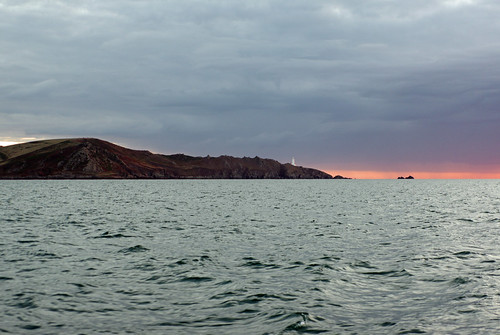The weather forecasts are driving me to distraction! As things turned out I could have left Saturday and, with some night sailing and motoring been on the mooring in good weather on Sunday.
Sunday morning I woke up to no wind and did not check the forecast till past 09:30; the new forecast showed a relatively calm day with strong winds reaching the Hamble after c 04:00 Monday, quick calculations showed if I motored I could be in Hamble by 02:00, tight but possible with Portland Marina a safe fall back, the eco buoys at Studland would not be a sensible option with wind forecast to be F7 occ F8 for Monday.
I was underway within 10 minutes with washing up still to be done and bedding needing to be stored but with calm seas that was soon sorted and I motored across Lyme Bay making better than 6 knots in calm seas.
Typically the wind increased from 8 knots at 15:40 when I was 6 miles off the Bill of Portland with the tide about to turn adverse. By 16:26 it was blowing 16 knots and by 17:26 up to 20 but this time there was less tide and I had the wind and waves behind me and with some gentle surfing was making c 7 knots through the water and quite comfortable.
 |
| A rather more direct track eastbound than west bound. |
A decision had to be made, Portland or Hamble? According to the met office domestic forecast for Hamble I still had several hours in hand to get to Hamble but it did not feel right, it would mean a couple of expensive nights in the marina but it seemed sensible to go there.
Another decision was to go west or east of the Shambles bank. West is a good deal shorter but would have more adverse tide and goes rather close to the Portland Race. I went east as the safe option but I don’t think it took that much longer because as soon as I turned round the bank I had the tide c30 degrees off the bow rather than dead ahead and I made 6 knots over the ground to the harbour entrance.
 |
| Portland from south of the Shambles Bank |
Getting onto the pontoon was a big challenge, when I was allocated the berth I was very pleased, I would be almost dead into wind (I had said I was single handed and would not be able to get into a berth down wind) with a slight bias blowing me on to the pontoon, but when the gale arrived I would be blown off. Unfortunately in the 30 minutes it took to rig fenders etc. and to get into the marina the 20 knt wind had veered from SSW - SW to West I was going to be blown off.
Fortunately the berth master has realised what had happened and came a long way from the office to take my lines; but it was a fraught couple of minutes and two attempts before I was secure.
 |
| My route in cutting the corner a bit inside the buoy. |
It was a very good decision, by 02:00 the wind was over 20 knots and by 03:00 30 knots, getting onto the mooring in that would at best have been extremely difficult.
The down side is that the forecasts have changed again, on Sunday the gale was to blow through Monday night but as I write on Monday morning winds will keep me here until Thursday 🤬🤬🤬🤬🤬🤬!
The gale is also stronger than forecast, the wind gusting to 53 knots at the breakwater at 09:30.
55 nautical miles in nine and a half hours.
Update Monday evening. Perhaps Wednesday?
Selsey Bill to Lyme Regis - Strong wind warning
24 hour forecast: West or northwest 6 to gale 8, decreasing 4 or 5 later. Moderate or rough, becoming slight or moderate. Squally showers, fair for a time. Good, occasionally poor.
Outlook for the following 24 hours: Northwest 3 to 5. Slight or moderate, occasionally smooth in north. Showers. Moderate or good.






.JPG)
.JPG)
.JPG)


.JPG)
.JPG)

.JPG)
.JPG)
.JPG)


.JPG)
.JPG)






